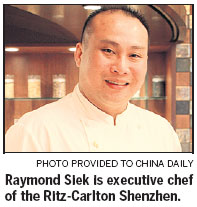Marrying culinary styles
Updated: 2014-02-08 07:24
By Pauline D. Loh (China Daily)
|
|||||||||||
Profile | Raymond Siek
Raymond Siek has literally cooked for thousands daily. As an executive chef on a cruise liner, he had to make sure the famous all-day buffet lines were constantly refreshed and replenished. Food had to look good, taste good and be abundantly presented.
Siek says that after that experience, anything else is a piece of cake.
His next moves up the culinary ladder were stints at upper-end resorts and five-star establishments that would have fazed a lesser chef. And now, as the executive chef of the Ritz-Carlton Shenzhen, he shares his experiences with both Chinese and Western chefs, bridging any culinary cultural gaps.
The Malaysian Chinese, who is just 39, grew up in Perak, Malaysia, a region known both for its ethnic diversity and its good food. His epicurean roots are reflected in the Asian menu in the Ritz-Carlton Shenzhen.
"The Asian dishes here are food well accepted by the local community, which is a god mix of people from surrounding countries. Malaysian food is very similar to dishes in Singapore, Indonesia, Brunei and Borneo. Food such as satay, nasi goreng (fried rice), roti paratha (Indian bread), popiah (spring rolls) and beef rending are all well known.

"At the Ritz-Carlton Shenzhen, I have all the secret recipes and ingredients, and I offer the tastes of home."
Siek's personal mix of epicurean influences marries the best of East and West, and it is this that gives him empathy with his team, both the Western-trained and Chinese chefs.
"My advantage is that I speak the language, and with Western chefs, I share their experiences and I support them in any way I can. But the secret is to be close to each and every one of your team members."
His own cooking style is a balance of Asian influences based on his Western kitchen training and in Shenzhen, it has found a faithful following.
"It's very unique and our guests are very appreciative. I have diners who come all the way from Hong Kong to eat at the Ritz-Carlton."
Shenzhen is not quite known as a gourmet hub, having to compete with its sister cities of Hong Kong in the south and Guangzhou further north. But Siek sees a bright future for creative chefs.
"There is always room to improve, I have to say. There are not many international restaurants in Shenzhen, but you can find good, authentic food styles here. Although it is a city of immigrants, Shenzhen actually benefits from the people from Guangzhou and Hong Kong who come here. They bring with them their experiences, food, family and culture."
There are also the gradual changes that are affecting not just Shenzhen, but China as a whole.
"The younger generation tends to be open to more new cultures and cuisine. Their willingness to explore and try new things motivates chefs to come out with more creative food."
For Siek at least, he is leading the pack in making Shenzhen the new culinary center for those tiring of the high prices and over-crowded scenes in the surrounding cities. Like he says, there is so much room for creativity.
paulined@chinadaily.com.cn
(China Daily 02/08/2014 page13)
Today's Top News
Xi attends Sochi Olympic opening ceremony
Turkey seize suspected hijacker
Sochi boosts China-Russia ties
China changing the way it drinks
Senate confirms Baucus as ambassador to China
Record number of Chinese enjoy festival overseas
Shanghai kindergartens to promote local dialect
Faulty Chinese part forces major Aston Martin recall
Hot Topics
Lunar probe , China growth forecasts, Emission rules get tougher, China seen through 'colored lens', International board,
Editor's Picks

|

|

|

|

|

|





